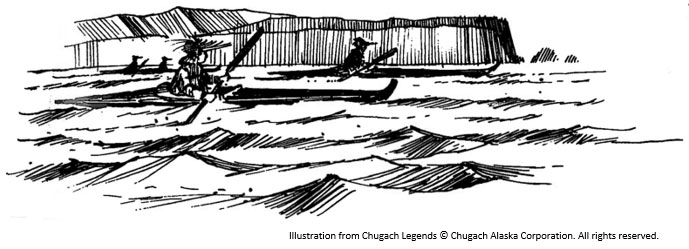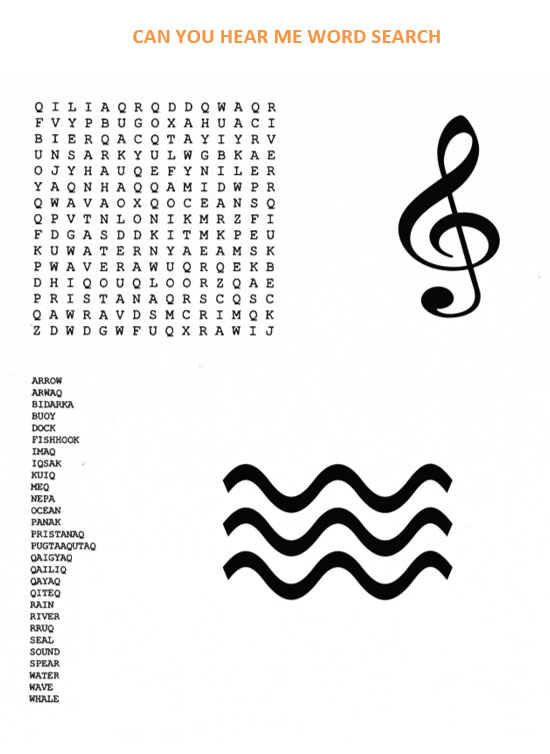Unit 5: Physical Science Principles in Everyday Life – Bentwood Hats
Every day, we interact with different forms of energy and matter.
Lesson Plan 2 “Can you hear me? Bentwood Hats”

Summary: Students will learn about sound and sound waves, and how the traditional Alutiiq bentwood hats amplify sound. Students will also learn about other qualities of bentwood hats, make bentwood hats of different materials and sizes, and try and test them out.
Grade Level:
K-4 / 5-8 / 9-12
Time Required:
Five to ten class periods of 45-60 minutes.
Materials Needed:
• Traditional bentwood hats
• Material to make the hats (e.g. paper, cardboard, beads, watercolors)
• Science Journals
• Video camera
• Digital camera
Learning Objectives:
• Students will understand that sound is a form of energy that travels in waves referred to as compression waves and understand that sound waves can travel through different mediums, e.g. solids, liquids, and gases.
• Students will also learn and observe that sound waves travel in a given direction until an outside force or object gets in the way of its motion and reflects it.
• Students will report why the seal hunters used traditional Alutiiq bentwood hats.
Vocabulary introduced:
Sound, sound waves, amplify, velocity, frequency, bentwood hat/visor
National Science Education Standards:
Physical Science
Content Standard B: As a result of the activities in grades K-4, all students should develop an understanding of the following:
• Properties of objects and materials
• Position and motion of objects
• Light, heat, electricity, and magnetism
Content Standard B: As a result of their activities in grades 5-8, all students should develop an understanding of the following:
• Properties and changes of properties in matter
• Motions and forces
• Transfer of energy
Content Standard B: As a result of their activities in grades 9-12, all students should develop an understanding of the following:
• Structure of atoms
• Structure of properties of matter
• Chemical reactions
• Motions and forces
• Conservation of energy and increase in disorder
• Interactions of energy and matter.
Alaska State Standards:
Concepts of Physical Science
A student should understand and be able to apply the concepts, models, theories, universal principles, and facts that explain the physical world.
A student who meets the content standard should be able to develop the following:
• An understanding of the characteristic properties of matter and the relationship of these properties to their structure and behavior;
• An understanding that energy appears in different forms, can be transformed from one form to another, can be transferred or moved from one place or system to another, may be unavailable for use, and is ultimately conserved;
• An understanding of the interactions between matter and energy, including physical, chemical, and nuclear changes, and the effects of these interactions on physical systems; and
• An understanding of motions, forces, their characteristics and relationships, and natural forces and their effects.
Background Information:
Borrow a collection of bentwood hats from community members for the students to use. Review the importance of respect for other people’s property when they loan an item to you with the class.
Find out who the bentwood hat makers are in your community as well as the hunters that have used them on the open water and invite them into the classroom to share their knowledge. Contact the Tribe (see Community Contacts).
Meet the community members prior to their visit to the classroom so they understand what you would like them to share and let them become familiar with the classroom.
Have water or tea for the guest to drink during their visit to the classroom.
Review social expectations with the class prior to the guest speaker (sitting respectfully listening to stories, waiting until the speaker has finished talking before asking questions, offering assistance/escorting when the speaker is leaving).
Have a small gift of thanks for the guest (something made by the class, or a card, and follow with a letter from the students).
 Listen to the Audio: Interview with Andrew Abyo about making Alutiiq bentwood hats, 2011.
Listen to the Audio: Interview with Andrew Abyo about making Alutiiq bentwood hats, 2011.
Resources: Alutiiq Words
Hunting, Fishing and Boating Related Terms
| Arrow | rruq |
| Boat | palagg’uutaq |
| Bow of boat | cuunga |
| Stern of boat | kingua |
| Bow (and arrow) | pitegcaq, petegcaq |
| Buoy | pugtaaqutaq |
| Compass | kampaasaq |
| Dock | pristanaq |
| Drawstring (for bow) | qelun |
| Fire/campfire | keneq |
| Fish spear | apsuun, kapsuutaq |
| Fish hook | iqsak |
| Gas | kaasaq |
| Grill net | naptestaaq |
| Seine net | kugyaq, kugyasiq |
| Gun, rifle | nutgutaq |
| Hunt/hunting | pisurluni |
| Kayak/bidarka | qayaq |
| Lantern (gas) | agg’wanaluq |
| Loud | kallagtuluni |
| Oar, paddle | pakiu’un |
| Ocean | imaq |
| Ocean swell | ikuak |
| Rain | qiteq |
| River | kuiq |
| Seal | qaigyaq |
| Fur seal | aataak |
| Ship | palagg’uutaq |
| Skiff | tuulaq |
| Snare | negaq |
| Sound | nepa |
| Sounds | nepet |
| Spear | panak |
| Spear it | panagluku |
| Fish spear | tuqsiiq |
| Water | meq |
| Wave | qailiq |
| Weapon | pisuutaq |
| Whale | arwaq |
| Killer whale | arlluk |
(From Nanwalegmiut Paluwigmiut-llu Nupugnerit – Conversational Alutiiq Dictionary, Kenai Peninsula Alutiiq by Jeff Leer, 1978)
Resources: Literature, audio, video, other curriculum
Literature
• Alaska Department of Fish and Game. Harbor Seal Species Profile. Available online: http://www.adfg.alaska.gov/index.cfm?adfg=harborseal.main
• Alaska Department of Fish and Game. Wildlife Notebook: Harbor Seal. Available online: http://www.adfg.alaska.gov/static/education/wns/harbor_seal.pdf
• Ardley, Neil. Science Book of Sound. 1991. Houghton Mifflin Harcourt Publishing.
• Dick, Alan. Dealing with Accelerating Change, Chapter: Bentwood Hats. COSEE Alaska. Available online: http://www.coseealaska.net/files/alaska/Ocean%20Science%20Fair%20Project%20Ideas.pdf
• Pledger, Maurice. Sounds of the Wild: Ocean. 2008. Silver Dolphin Books.
• Wynne & Folkens. Guide to Marine Mammals of Alaska. 2012. Alaska Sea Grant.
Video
• Chugachmiut. Making Traditional Alutiiq Visors. Video. 2001. http://www.iqsak.org/images/video/AlutiiqVisors.wmv
• Pratt Museum. Bisuhta: A Contemporary Alutiiq Sugpiak Seal Hunt in Kachemak Bay, Alaska. 1999. http://www.iqsak.org/images/video/BishuntaSealHunt.wmv
Other curriculum
• Chugachmiut Driftwood Heritage Kit
• Discovery Education, Lesson plan about sound for K-5: http://www.discoveryeducation.com/teachers/free-lesson-plans/the-phenomenon-of-sound-waves.cfm
SmartBoard
• Sound. Students will learn that sound is a form of energy that travels in waves and understand the different aspects of sound and differentiate between them. (3-7). http://exchange.smarttech.com/details.html?id=dcc6d381-1054-4227-bd91-2571b547da07
• Lesson About Sound. Lesson about Sound. Lots of matching activities and animations (2). http://exchange.smarttech.com/details.html?id=d8f74119-74a1-440c-8bd8-b86dbc4d129a
Procedure:
Engagement
• Ask the students what sounds they can hear during their day. When are the sounds louder or quieter?
• Ask students to think about how the hunters would traditionally locate animals when hunting.
Exploration
• Test the bentwood hats (either the borrowed ones or students’ paper hats) in the classroom. Can you hear a sound (like another person talking at the end of the room) better with the hat?
• Take the students to the beach and test the sound amplification and the bentwood hat operation from a boat. Can the person on the boat hear the person on the beach better with or without the bentwood hat? Does it make a difference if the water surface is still or broken? Record observations in science journals. Take video footage and digital photographs
• What other properties do the bentwood hats have?
• Ask students to identify the seal species that are found in the region.
• Explain to the students why seal has been such an important mammal for the Alutiiq culture. (Preserving food in seal oil, meat, fur, etc.)
Explanation
• Introduce the vocabulary terms and definitions.
• Explain that sound is a mechanical vibration that travels through matter as a waveform. It consists of longitudinal or compression waves in matter. Sound will readily travel through water. The sound wave form moves at approximately 1130 feet/sec. or 770 miles per hour at room temperature or 70 degrees Fahrenheit. The frequency of sound is the rate at which the waves pass a given point; the relationship between velocity, wavelength and frequency is: velocity = wavelength x frequency.
• Direct students to do further research on sound and write a report.
• Have students share observations about the experiments in the classroom from using the bentwood hats.
• Explain to students that the hats were used during seal hunting. There may be students with this knowledge they may be willing to share in the class.
• Invite an Elder to the class to discuss how they made the hat and what their experience was while hunting seal.
• Have students recreate a bentwood hat for themselves under the guidance of the Elder.
Elaboration
• Have student interview family/community members to answer the question: In what other Alutiiq cultural activities does sound have an important role? Write the interview into story format to share with the class.
• Ask the students to find out what the different markings and decorations on the bentwood hats stand for?
Evaluation
• Student participation
• Interview results
• Student report
• Science Reports
• Student correct use of vocabulary
• Student bentwood hats
Follow Up Activities:
• Learn about different animal calls with elders. You can also go to “Sounds Wild” pages and listen to various animal calls at http://www.adfg.alaska.gov/index.cfm?adfg=viewing.seasonal&_ga=2.93866522.622664862.1514492536-777892550.1514492536 & http://www.adfg.alaska.gov/index.cfm?adfg=viewing.what & http://www.adfg.alaska.gov/index.cfm?adfg=educators.teacherresources
• Make different AK native style drums. What design is used in your region? Test out different kinds of drums. Why do they sound different? See “Alaska Science Camps, Fairs & Experiments: Drum Frames. Page 117. Alaska Native Knowledge Network/Alan Dick. 2004.
• Make a traditional Chugach region bentwood hat, decorate and paint it. Ask an elder or a community artist to help with this.
• Play the “Can you hear me” word search (you can find the activity sheet in the Document Library and print them out, or use SmartBoard).

